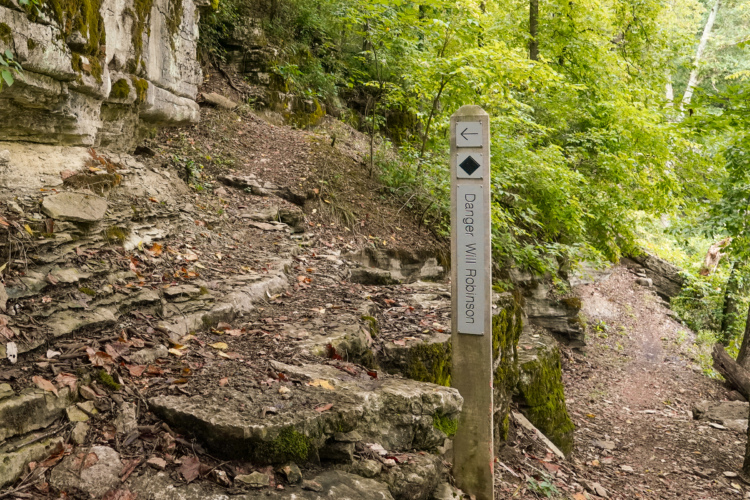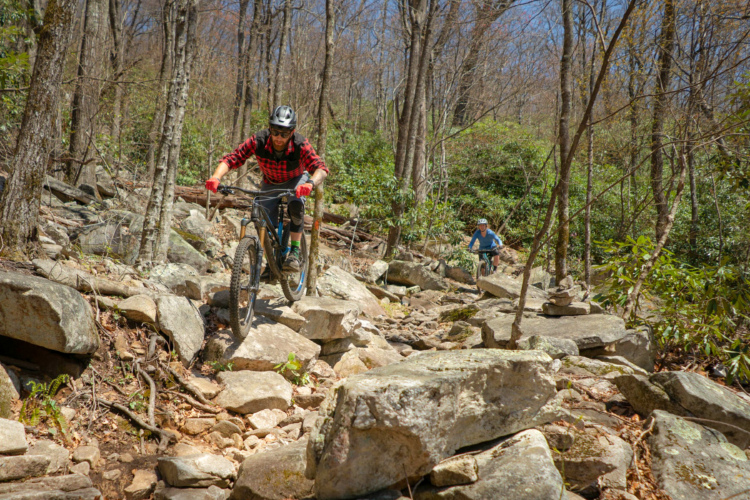
When I started riding back in the early 1990s, there was basically just one flavor of mountain biking but today MTB categories can get a little confusing. I found this helpful chart over on the Turner website and I think it does a good job illustrating some of the divisions you’ll find in mountain biking find today. The arrows and text below the chart were added for the purposes of this post.
Right off the bat you can see the spectrum of riding from XC to Downhill and everything in between. Notice how the plot gets higher and more jagged as you move to the right, representing technical difficulty (not necessarily climbing or aerobic difficulty). It’s also cool to think of this as a progression chart – beginners can move from XC to AM and beyond as skills improve.
I really like how this chart can be used to show ranges rather than discreet points along the spectrum. In this particular chart, the shaded green area represents recommend usage for the Turner 5.Spot. Notice how it isn’t just a Trail or All Mountain bike. Based on the geometry and travel (5.5″ rear) this bike works well for XC, Trail, and AM riding.
The spectrum approach is also helpful for classifying riders. Most of us enjoy a variety of terrain and saying someone is strictly a Freerider or Downhiller usually doesn’t tell the whole story.
But wait, this chart has one more trick up its sleeve! Most mountain bike trails themselves can’t be readily classified into one type or another. A mellow XC trail may have 5 foot drops in places or even a freeride area that’s 5 miles into the trail. Other trails may have short bursts of All-Mountain style terrain with XC-type fireroads connecting sections. In fact I imagine some trails could cover the entire spectrum from XC to Downhill while others fit more neatly into a single category.
Some generalities about mountain bikes can be made from this chart and I’ve added arrows describing just a few trends you can expect to see when purchasing a new mountain bike. As you move from left to right, travel (front and rear) should increase while weight will follow roughly the same trend. Price, on the other hand, isn’t so easy to classify. For example, remember this $7,000 XC hardtail from Interbike? Finding a DH bike that costs half that amount wouldn’t be too hard (nor would finding a DH bike costing 50% more).
Now, if it were possible to create a mountain bike that could cover the entire chart from XC to DH that would be the holy grail. Maybe the Cannondale Simon will deliver on that dream one day 🙂











10 Comments
Oct 10, 2009
Jeff, they huck HT bikes off of 15' plus drops all the time. I see them all the time at Santos and at our local FR trail. I am getting a progressive HT at the end or beginning of this year and I will be hucking it of 10' plus drops. Now there are HT bikes and FS bikes that I would not recommend hucking off a 10' drop by no means.
May 17, 2019
Oct 11, 2009
Oct 10, 2009
Oct 9, 2009
There are folks out there like your self that would rather have a bigger bike and ride it all the time for example and then people who are like myself who like to both go big and who like to also enjoy the climb up a hill...Although I do like mostly pointing down...he he ... Shhhhh don't tell my wife.
And if you look at the line up this year there are going to be many bikes that really will blur the lines. Such as the Giant Trance....Which could almost be considered a racer for some folks as well as a great trail bike. Or the Specialized enduro which I have seen folks do 20 - 30 foot expansions as well as climb decently enough to hang with the dude with the Trance..If you look at a lot of the new FR and DH bikes they are even coming down in weight, under 40Lbs.
Cheers..
Oct 9, 2009
Either get a bike for XC riding, a bike for FR to DH riding, or just get a bike that fits into both of those disciplines, like a trail bike/slopestyle. The latter half will do all! Jeez, its real simple, if all you want to do is race a MTB or just ride some off-road trails, then stick with a lighter weight weenie XC bike, but if you want a beefer bike that can still climb but take on some FR or some real DH runs, then stick with a trail bike/slopestyle. Now, if you want a full blown bike that can take the punishment of FR or gnarly DH runs, then stick with the beefer FR/DH bikes, but remember, they are not a climbing bike (unless you have legs of superman), but made to be shuttled up. I will say one thing, and I do not have anything against 29ers, but the 26ers and 29ers do not have a place together racing. They need to be a separate class of bike racing. Just my two cents.....Peace Out!
May 17, 2019
May 17, 2019
Oct 10, 2009
Oct 7, 2009